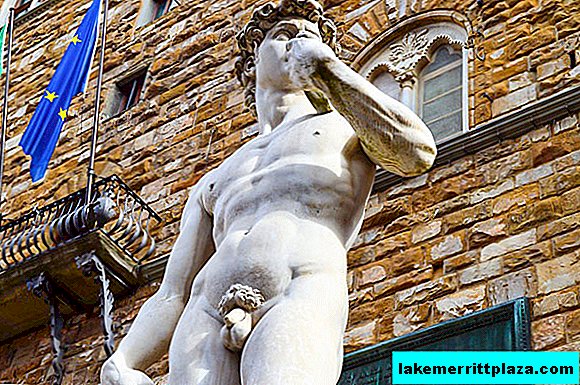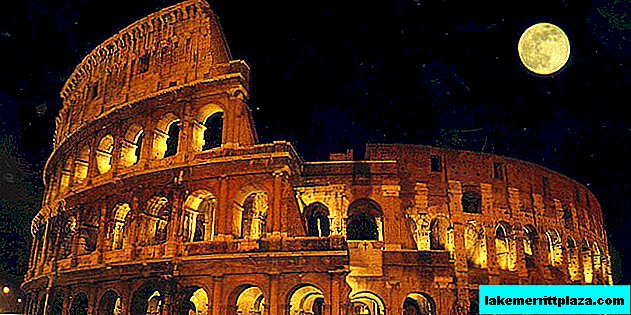Statue of David by the outstanding Renaissance craftsman Michelangelo di Buonarroti (Michelangelo di Buonarroti, 1475-1564) is in the Gallery of the Academy of Fine Arts (Galleria dell'Accademia) in Florence.
Description
The sculpture, made of a monolithic block of valuable Carrara marble, has a height of 5.17 meters and a weight of more than 6 tons. "David" is recognized as the standard of male beauty of the Renaissance and one of the most significant masterpieces of world art.

The image of the biblical king inspired the masters before, but all the predecessors of Michelangelo (Donatello, Andrea del Verrocchio) portrayed him as the winner, at whose feet Goliath's head fell. Buonarroti's artistic innovation was that he first captured the hero in preparation for the decisive battle. The statue depicts a naked young man with a powerful physique, ready for battle with a dangerous enemy. His proud head with a shock of hair, frowning eyebrows and firmly compressed lips speak of an unbending will.

The lines of the body are anatomically perfect, a relaxed posture indicates confidence and strength, a sling thrown over the left shoulder promises a deadly attack to the enemy.
The sculptural image of the Jewish king was commissioned by Michelangelo in 1501 by the guild of wool merchants. It was this association that was responsible for decorating the Cathedral of Santa Maria del Fiore (La Cattedrale di Santa Maria del Fiore). Florence was rightly proud of the temple, its worthy design was a matter of honor for the workshop foremen. The statue was to become part of the sculptural ensemble, consisting of twelve characters of the Old Testament. This was not to be realized.

During the work on David, not only the creative biography of the Tuscan sculptor changed dramatically, but also the political life of the republic. Initially, the order was only religious in nature. But during the creation of the sculpture, Florence expelled the tyrants of the Medici and "David" Michelangelo became a symbol of republican freedom and the defense of the fatherland from the tyrants.
History of creation
The history of the Florentine Republic is closely intertwined with the creation of a world masterpiece. The picture of the medieval world had few shades of free thought, the Italian city-states were a unique phenomenon of that time. Florence never obeyed papal bulls and ducal decrees, only human genius was its immutable law.
The work lasted two years and four months. The master at that time was 26 years old, but he managed to become famous as a great sculptor, eclipsing Leonardo himself. Michelangelo held the most difficult exam in his life, for any artist of that time it was important whether Florence recognized his skill.
The story of the birth of a masterpiece is unusual. An interesting description of the work of Buonarroti on the statue is given by his contemporary Giorgio Vasari. According to his records, the master received a marble block already spoiled by notches and chips. The shape of the future sculpture had to be chosen so that these defects were not noticeable.
There were no assistants; Michelangelo worked alone, moving around a giant block through scaffolding. The work took place in complete secrecy, the place where the statue was created was fenced with a wooden fence. When it was almost completed, the master spent four months on finishing and polishing.
In January 1504, the sculpture was seen and appreciated by leading Florentine craftsmen. An authoritative group with Leonardo da Vinci at the head considered it worthy to decorate the heart of the city - Piazza della Signoria. At the insistence of Leonardo and with the consent of Michelangelo, “David” was installed at the entrance to the Loggia de Lanzi, where the meetings of the City Council were held. There he stood for more than three hundred years and only in 1873, in order to avoid the negative effects of precipitation and weathering, was transferred to the main hall of the Gallery of the Academy of Arts.
Copies
- The most famous is located in Piazza Signoria in Florence, where the original was originally installed.

- Another - also in Florence, in Piazzale Michelangelo, is made of bronze. The square was built on the left bank of Arno in 1869, it is interesting for tourists, as it offers a magnificent view of the city.

- A plaster copy is in the Victoria & Albert Museum in London. A funny story is connected with it: in case of visits of Queen Victoria, the causal place of the statue was covered with a removable fig leaf.

- The Italian courtyard of the Pushkin Museum in Moscow also boasts its “David”.

Interesting Facts
- The statue "David" from the place of work to Signoria Square was delivered in a specially designed bull cart in 4 days. All of Florence has witnessed an amazing sight. Several envious Michelangelo tried to throw stones at the sculpture, for which they ended up in prison.
- In 1527, David suffered from political debate - a bench flying out of a Palazzo Vecchio window damaged his left arm. The restoration was performed by Vasari.
- Florence gave Jerusalem a cast from a sculpture. The gift was not accepted, Jerusalem authorities were outraged that David was naked and not circumcised.
- In 2004, Florence celebrated the 500th anniversary of the creation of the masterpiece. In honor of this event, the sculpture was washed for the first time in 130 years.
- A recent study revealed the threat of the destruction of the statue from tremors. According to the Minister of Culture of Italy Dario Franceschini, 200 thousand euros will be allocated for the installation of an earthquake-resistant pedestal.
Where is it, opening hours, tickets

- The Academy of Arts Gallery is located on 66 Ricazoli Street, Florence (Via Ricasoli 66, 50122 Firenze).
- The museum is open from Tuesday to Sunday from 8:15 to 18:50, the ticket office closes at 18:20, Monday is a day off. Ticket price - 8 euros, for citizens of EU countries aged 18-25 years to provide an identity card - 4 euros.
- The official website of the Gallery: www.polomuseale.firenze.it. To avoid the queue at the box office it is recommended to book or buy tickets online.
- The collection of exhibits deserves attention, and other works of Michelangelo are presented: “Pietta Palestrina” (Palestrina Pieta), “Four Slaves” (Prigioni), “Saint Matthew” (San Matteo). Gallery photography allowed without flash.












